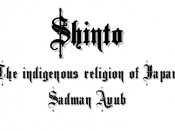�PAGE � �PAGE �1�
Shinto "The indigenous religion of Japan"
Sadman Ayub
Summary
This paper will take an in depth look at a very popular and sacred religion in the east, Japan in particular, and the religion being Shinto. Shinto does not have a founder nor does it have sacred scriptures like the Quran or the Bible. Propaganda and expansion are not common either, because Shinto is deeply rooted in the Japanese people and traditions.
"Shinto gods" are called kami. They are sacred spirits which take the form of things and concepts important to life, such as wind, rain, mountains, trees, and rivers. In contrast to many monotheist religions, there are no absolutes in Shinto. There is no absolute right and wrong, and nobody is perfect. Shinto is a positive faith, as humans are thought to be primarily good, and evil is believed to be caused by evil spirits. Therefore, the purpose of most Shinto rituals is to keep away evil spirits by purification, prayers and offerings to the kami.
Introduction
Shinto ("the Way of the Gods") is the native religion of Japan. It is a religion resulting from animist and shamanic practices (worship of the sun, nature and the ancestors in particular.) Its followers honor countless divinities called Kami (in general, personified nature's forces, but also sacred ancestors, trees, stones, objects, etc...). It does not have holly texts and its mythology is partly described in two fundamental books: the Kojiki and the Nihongi. Shinto is the indigenous religion of Japan.
History
The Shinto religion's bases were established in the Yayoi era (~300 BC - ~300 AD) and organized in the 7th century to distinguish Shinto from Buddhism, which lately arrived from Korea. It is in 712 and 720 that the Kojiki and the Nihongi were written, on the...


